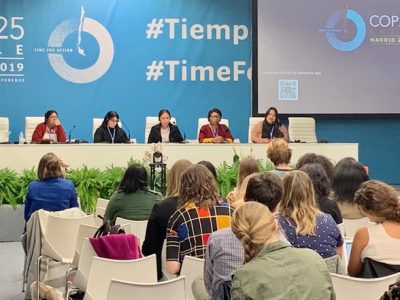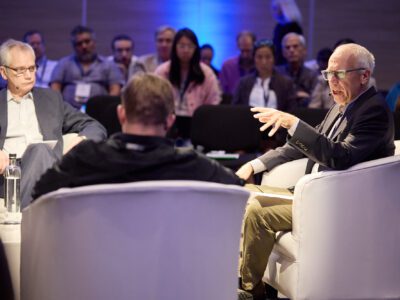Guest Blogger Idalmis Vaquero: Women of Color Leading Climate Justice at COP 25
Young Advocates Call For More Inclusive and Culturally Responsive Negotiations

Four years after the Paris Agreement was adopted by member countries of the United Nations Framework on Convention on Climate Change, countries are still working out the details on how they will reduce their carbon emissions. This year the Conference of the Parties (COP) 25 is taking place in Madrid, Spain under the leadership of the Chilean government. I am a law student at UCLA School of Law attending these talks as a credentialed delegate, and I have been struck by a noticeable representation of young women promoting climate justice at COP 25 through the inclusion of gender, queer, and indigenous rights within the Paris Agreement.
Self-identified young feminists from countries like Nigeria, the Philippines, and Guatemala are asking the COP to take more aggressive steps to protect environmental justice communities from further harm through Article 8 of the Paris Agreement. Article 8 recognizes the need to avert, minimize, and address the loss and damage of climate crisis events by enhancing emergency preparedness, responding to slow onset events and events that involve irreversible and permanent loss and damage, building capacity for comprehensive risk assessment and management, and increasing the climate resiliency of communities and ecosystems. In particular, a young Filipina feminist at a side event panel titled “Global South Women and Young Feminist Meet the Climate Crisis: Alternatives, Solutions, and Narrative” discussed how women are more vulnerable to dying during typhoons in her country because of a lack of preparation on the particular issues women face. By incentivizing an emergency preparedness process that is more gender-inclusive and culturally-inclusive, she points out, the COP can help ensure everyone will be equally protected during emergencies.
This panel of young feminists outlined for the audience the ways gender and climate are connected. Even though women and non-binary people are disproportionately impacted by the effects of climate change, they are not adequately represented in the negotiations happening behind closed doors at COP 25. The negotiations are male-dominated by countries of the Global North. The COPs are also often inaccessible to indigenous peoples who are not recognized by the UNFCCC as parties, and those who want to attend must go through an accreditation process that on average takes a year. Even when indigenous and young feminists have the credentials to attend and obtain access as observers, they unfortunately often do not have the financial capacity to bring large delegations that would allow them to simultaneously track all of the subtopics under negotiation.
The panelists are working to push the possibilities of what the COP can be. They are demanding that the negotiating spaces open up for women and non-binary people in order to ensure that gender is a part of every conversation at the COP. As storytellers, they hope to continue bringing women’s stories to the forefront of these conferences so that the focus is not just emission numbers and degree goals. They hope to elevate the faces of our climate crisis on this international stage and reach a wider audience. At home, these women are also engaging with their national governments, building capacity with women to learn about policy making and climate change, and organizing youth and women to lead the climate justice movement.
I am inspired by these young feminists who continue fighting for climate justice at the COP and at home using an intersectional lens to ensure that differently-abled, queer, and indigenous peoples join them at COP meetings in the years to come.
Idalmis Vaquero is a J.D. candidate in her second year at UCLA School of Law.






Reader Comments